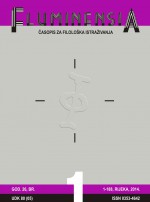THE DOUBLE IN JEAN DE ROTROU’S SOSIES AND MOLIÈRE’S AMPHITRYON
Keywords:
Amphytrion, baroque, double, French theatre, identity, the self, Jean de Rotrou, MolièreAbstract
Ever since Antiquity the story of Amphitryon and his wife Alcmene has been drawing attention of writers belonging to different periods of literary history, among others, Plautus, John Dryden, Heinrich von Kleist, Jean Giraudoux, Luis de Camões, Georg Kaiser, Peter Hacks and Ignacio Padilla. Amphitryon and Sosies’s destinies were the topics of Jean de Rotrou’s (Sosies, 1636) and Molière’s (Amphitryon, 1668) comedies. This paper focuses on the analysis of the double in these two texts, Sosies and Amphitryon. The paper, in its introductory part, analyses intertextual relations between Rotrou’s and Molière’s texts, as well as their relationship with Plautus’s template. The comic potential of these texts resides in the appearance of physical doubles that steal the main character’s identities. The analysis is based on Jacques Lacan’s concept of a Mirror stage. The motif of the double in Rotrou’s and Molière’s comedies is related to the anxiety provoked by the 17th century epistemological rupture.

